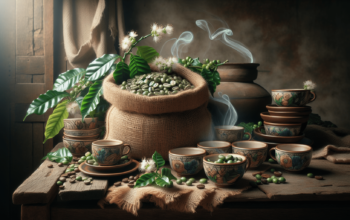Have you ever wondered about the fascinating world of coffee varieties? There’s an entire universe of flavors, aromas, and stories waiting for you to uncover, each one reflecting the region it comes from and the unique cultivation practices involved. Today, let’s take a closer look at some of the most extraordinary coffee varieties found around the globe.
Understanding Coffee Varieties
When we talk about coffee, many people picture their daily cup of java. However, there’s a lot more to coffee than just the beverage. Coffee varieties play a significant role in determining taste, aroma, and even how the beans are processed.
The main species of coffee you’ll encounter are Arabica and Robusta. Arabica is typically known for its sweet, soft flavor, while Robusta is often stronger and more bitter. But within these species, there are numerous varieties, each bringing its own set of distinct characteristics.
The Popular Varieties of Arabica Coffee
Arabica coffee is celebrated for its exquisite flavor profile and accounts for around 60-70% of global coffee production. Let’s explore some of its most popular varieties.
Typica
Typica is considered one of the foundational coffee varieties from which many others have descended. Grown primarily in Latin America, this variety produces beans with a smooth, sweet profile and bright acidity. You might enjoy notes of caramel and almonds, making it a favorite among coffee connoisseurs.
Bourbon
Another classic variety, Bourbon, originated from the island of Réunion (formerly Ile Bourbon) and has expanded to regions like Central and South America. Its flavor is marked by a rich, buttery body and a complex sweetness. If you’re searching for chocolatey or fruity undertones in your cup, Bourbon might just be your new best friend.
Geisha
You’ve probably heard of Geisha coffee thanks to its rising fame in specialty coffee circles. Originating from Ethiopia and later popularized in Panama, this variety is renowned for its distinct floral and jasmine-like aroma. The complex flavor profile can include notes of bergamot and tropical fruits. Geisha is often considered one of the most expensive coffees on the market, primarily due to its limited production and unique taste.
Caturra
Caturra is a mutation of Bourbon and was discovered in Brazil. With a more compact growth structure, this variety is often easier to cultivate. The flavor tends to be bright and crisp, with notes of citrus and a creamy body. If you appreciate a refreshing cup of coffee, Caturra is worth seeking out.
SL28 and SL34
These two varieties were developed by Scott Agricultural Laboratories in Kenya. SL28 is known for its fruity and wine-like flavors, often exhibiting notes of blackcurrant. SL34, although similar, tends to be a bit more structured and balanced, making both varieties prized possessions among coffee lovers.
Pacamara
A hybrid of Pacas and Maragogipe, Pacamara coffee is unique not just for its flavor but also for its large beans. This variety produces a rich body with a unique blend of flavors, including chocolate and fruit. If you’re searching for something different, you might want to sample some Pacamara.

The Resilient Robusta Varieties
While Arabica may hold the spotlight in specialty coffee, Robusta is celebrated for its resilience and higher caffeine content. Let’s take a look at some notable Robusta varieties that add depth to the coffee world.
Conilon
Conilon is a Brazilian variety that represents over half of the country’s Robusta production. It features a smooth, sweet flavor profile with a low acidity. If you’re in the mood for a milder cup of coffee, Conilon is an excellent choice.
Nganda
Nganda is a variety grown mainly in the Democratic Republic of the Congo, known for its resistance to disease. The flavor is earthy and rich, providing a strong cup that can stand up well to milk and sugar. If you enjoy making creamy lattes, you might find Nganda to your liking.
Robusta Timor
Originating from Timor Island, this variety is a hybrid between Arabica and Robusta, which gives it some unique characteristics. It often has a broader flavor palette, mixing the sweetness of Arabica with the strong, bitter notes of Robusta. If you’ve ever enjoyed a robust espresso, chances are Robusta Timor was involved.
Coffee Varieties by Region
Coffee is cultivated in more than 70 countries around the world, and each region has its own signature varieties shaped by local climate and soil conditions. Let’s look at some of the fascinating coffee varieties produced in different regions.
Latin America
Latin America boasts a rich tapestry of coffee varieties. Besides the previously mentioned Typica and Bourbon, you can find many other unique beans here.
Castillo
Castillo is a variety developed in Colombia to combat diseases affecting traditional varieties. While some purists believe it lacks complexity, many appreciate its smooth, balanced flavors and lower acidity, making it a go-to for everyday drinking.
Mundo Novo
A natural hybrid of Bourbon and Typica, Mundo Novo is favored for its hardiness and high yields—qualities that have made it popular among farmers in Brazil. It produces a sweet, chocolatey cup with a medium body.
Africa
Africa is known as the birthplace of coffee, and its coffee varieties reflect the continent’s unique climates and cultures.
Ethiopian Yirgacheffe
This coffee comes from the Yirgacheffe region of Ethiopia and is often praised for its complex flavors, which can include citrus, floral, and even tea-like qualities. If you appreciate a light, aromatic coffee, Ethiopian Yirgacheffe may tickle your taste buds.
Kenyan AA
Known for its distinctive bright acidity and fruity notes, Kenyan AA is grown at high altitudes, leading to dense beans that result in a powerful flavor. This variety is particularly delightful for those who enjoy a bold cup of coffee.
Asia
Asia offers a fascinating array of coffee varieties, particularly significant in countries like Vietnam and Indonesia.
Robusta from Vietnam
Vietnamese coffee is largely based on Robusta beans, which thrive in the country’s climate. When prepared as Vietnamese iced coffee, you can savor a rich, strong cup that’s often sweetened with condensed milk, creating a delightful contrast of flavors.
Sulawesi Toraja
Originating from the Toraja region of Indonesia, this variety exhibits earthy, full-bodied flavors with a hint of spice. It’s often described as having a “woody” finish, providing a unique experience for adventurous coffee drinkers.

Specialty Coffee and Unique Processing Methods
One of the fascinating aspects of coffee is how processing methods can impact the final taste. Different techniques can extract various flavors from the same origin and variety, leading to a unique experience in each cup.
Washed Process
In the washed process, the coffee cherries are depulped, and the beans are fermented to remove the mucilage. This results in a cleaner taste, which highlights the beans’ inherent flavors. This method is commonly used for high-quality coffees, particularly in Central America.
Natural Process
In contrast, the natural process allows coffee cherries to dry in the sun before the beans are extracted. This method imparts fruity and wine-like characteristics to the coffee. Ethiopian coffees are often processed this way, leading to a vibrant and complex flavor profile.
Honey Process
The honey process is a hybrid technique where the cherries are pulped, leaving some mucilage on the beans during drying. This method can lead to a sweet and syrupy flavor, striking a balance between the washed and natural processes.
The Importance of Terroir
Just as wine reflects the region in which the grapes are grown, coffee is heavily influenced by its terroir—climate, soil, altitude, and even the local culture. This is why coffee from different regions has distinct flavors even if they use the same variety.
Altitude
Growing coffee at high altitudes allows beans to mature more slowly, often resulting in denser beans with more complexity. Many of the world’s finest coffees, such as Ethiopian Yirgacheffe and Colombian coffees, are grown in high-altitude regions.
Soil Composition
Soil plays a crucial role in flavor development. Volcanic soils, for instance, are rich in minerals and nutrients, often leading to lively, flavorful cups. You’ll find exceptional coffees grown in volcanic regions, such as those in Colombia and parts of Indonesia.
Climate
Temperature, rainfall, and sunlight impact how coffee plants grow and when they produce cherries. For example, regions with a distinct wet and dry season can promote better flavor development, as seen in many Central American coffee-producing countries.
Understanding Coffee Grading
The grading of coffee reflects its quality and often helps determine market prices. Understanding this grading system can enhance your appreciation for specialty coffee.
Specialty Grade
Specialty coffee refers to beans that score 80 points or higher on a 100-point scale. These coffees are typically grown in ideal conditions and processed with care. They often exhibit unique flavor profiles that are cherished by coffee enthusiasts.
Premium Grade
Premium grade coffees score between 70 and 79 points. While they may not exhibit the complexity of specialty coffees, they are still considered high-quality and can provide a great tasting experience.
Exchange Grade
Exchange grade coffees are typically lower quality beans, scoring under 70 points. These are often used in commercial blends and may lack the distinctiveness that specialty or premium coffees offer.
Brewing Unique Coffee Varieties
Finding the perfect brewing method for your favorite coffee variety can make a world of difference. Here are some popular brewing techniques to enjoy unique flavors from your beans.
Pour-Over Method
Pour-over brewing allows you to control water temperature and flow rate, which can highlight specific flavors in the coffee. It works well for lighter roasts, such as Ethiopian Yirgacheffe or Geisha, to emphasize their fruity and floral notes.
French Press
The French Press method is excellent for showcasing the richness and body of coffee. It works well with medium to dark roasts like Bourbon or Pacamara, creating a deliciously full-bodied cup.
Espresso
Espresso extracts concentrated flavors in a small volume of water, making it a favorite for coffee lovers who appreciate intensity. Consider using robust varieties like Robusta Timor or blends designed for espresso preparation.
Cold Brew
Cold brew coffee has gained popularity for its smooth, mellow flavors. It’s often made with coarsely ground beans, allowing for a low-acidic and highly caffeinated drink. This method works wonderfully with beans from regions like Brazil or Colombia, particularly those with sweeter profiles.
The Impact of Sustainability
Sustainability is becoming an increasingly important topic within the coffee industry. Ethical sourcing, fair-trade practices, and environmentally friendly farming methods ensure that coffee is not only delicious but also responsible.
Supporting Farmers
By choosing to buy from sustainable sources, you help support the farmers who work tirelessly to cultivate the coffee you love. Look for certifications like Fair Trade or Direct Trade, which emphasize fair wages and better working conditions for growers.
Growing Practices
Sustainable farming practices, such as shade-grown coffee, have lesser environmental impact and contribute to biodiversity. These farms provide habitats for wildlife and help prevent erosion—factors that are vital for maintaining healthy ecosystems.
Environmental Impact
Utilizing eco-friendly practices can reduce water consumption and pesticide use, ultimately preserving vital resources. Many specialty coffee farmers are focusing on regenerative agriculture methods to create a more sustainable future.
Conclusion: Your Coffee Journey
The world of coffee varieties is rich and diverse, offering you a never-ending journey of discovery. From unique origins and flavors to different processing methods, each cup of coffee tells a story. As you explore this vast landscape, remember the importance of sourcing your beans ethically and appreciating the work that goes into each harvest. With each sip, you participate in a global community that celebrates craftsmanship, flavor, and the unifying power of coffee. So why not grab a cup, reflect on the variety you’re enjoying, and share this newfound knowledge with friends and fellow coffee enthusiasts? Your journey into the fascinating world of coffee is just beginning, and there’s always more to learn and savor.



